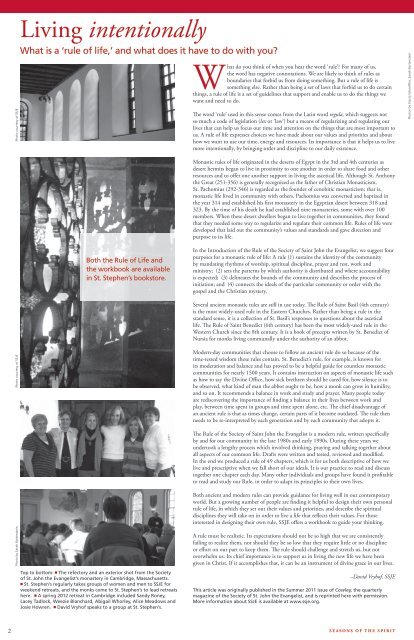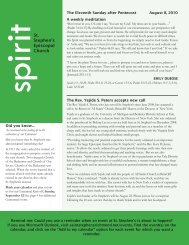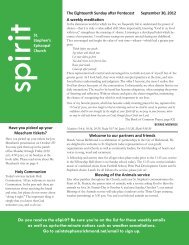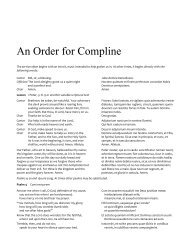What is a bishop? - St. Stephen's Episcopal Church
What is a bishop? - St. Stephen's Episcopal Church
What is a bishop? - St. Stephen's Episcopal Church
Create successful ePaper yourself
Turn your PDF publications into a flip-book with our unique Google optimized e-Paper software.
2<br />
Photo courtesy of SSJE<br />
Photo courtesy of SSJE<br />
Photo by Sarah Bartenstein<br />
Living intentionally<br />
<strong>What</strong> <strong>is</strong> a ‘rule of life,’ and what does it have to do with you?<br />
Both the Rule of Life and<br />
the workbook are available<br />
in <strong>St</strong>. <strong>St</strong>ephen’s bookstore.<br />
Top to bottom: ■ The refectory and an exterior shot from the Society<br />
of <strong>St</strong>. John the Evangel<strong>is</strong>t’s monastery in Cambridge, Massachusetts.<br />
■ <strong>St</strong>. <strong>St</strong>ephen’s regularly takes groups of women and men to SSJE for<br />
weekend retreats, and the monks come to <strong>St</strong>. <strong>St</strong>ephen’s to lead retreats<br />
here. ■ A spring 2012 retreat in Cambridge included Sandy Roney,<br />
Lacey Tadlock, Weezie Blanchard, Abigail Whorley, Alice Meadows and<br />
Josie Howren. ■ David Vryhof speaks to a group at <strong>St</strong>. <strong>St</strong>ephen’s.<br />
<strong>What</strong> do you think of when you hear the word ‘rule’? For many of us,<br />
the word has negative connotations. We are likely to think of rules as<br />
boundaries that forbid us from doing something. But a rule of life <strong>is</strong><br />
something else. Rather than being a set of laws that forbid us to do certain<br />
things, a rule of life <strong>is</strong> a set of guidelines that support and enable us to do the things we<br />
want and need to do.<br />
The word ‘rule’ used in th<strong>is</strong> sense comes from the Latin word regula, which suggests not<br />
so much a code of leg<strong>is</strong>lation (lex or ‘law’) but a means of regularizing and regulating our<br />
lives that can help us focus our time and attention on the things that are most important to<br />
us. A rule of life expresses choices we have made about our values and priorities and about<br />
how we want to use our time, energy and resources. Its importance <strong>is</strong> that it helps us to live<br />
more intentionally, by bringing order and d<strong>is</strong>cipline to our daily ex<strong>is</strong>tence.<br />
Monastic rules of life originated in the deserts of Egypt in the 3rd and 4th centuries as<br />
desert hermits began to live in proximity to one another in order to share food and other<br />
resources and to offer one another support in living the ascetical life. Although <strong>St</strong>. Anthony<br />
the Great (251-356) <strong>is</strong> generally recognized as the father of Chr<strong>is</strong>tian Monastic<strong>is</strong>m,<br />
<strong>St</strong>. Pachomius (292-346) <strong>is</strong> regarded as the founder of cenobitic monastic<strong>is</strong>m; that <strong>is</strong>,<br />
monastic life lived in community with others. Pachomius was converted and baptized in<br />
the year 314 and establ<strong>is</strong>hed h<strong>is</strong> first monastery in the Egyptian desert between 318 and<br />
323. By the time of h<strong>is</strong> death he had establ<strong>is</strong>hed nine monasteries, some with over 100<br />
members. When these desert dwellers began to live together in communities, they found<br />
that they needed some way to regularize and regulate their common life. Rules of life were<br />
developed that laid out the community’s values and standards and gave direction and<br />
purpose to its life.<br />
In the Introduction of the Rule of the Society of Saint John the Evangel<strong>is</strong>t, we suggest four<br />
purposes for a monastic rule of life: A rule (1) sustains the identity of the community<br />
by mandating rhythms of worship, spiritual d<strong>is</strong>cipline, prayer and rest, work and<br />
min<strong>is</strong>try; (2) sets the patterns by which authority <strong>is</strong> d<strong>is</strong>tributed and where accountability<br />
<strong>is</strong> expected; (3) delineates the bounds of the community and describes the process of<br />
initiation; and (4) connects the ideals of the particular community or order with the<br />
gospel and the Chr<strong>is</strong>tian mystery.<br />
Several ancient monastic rules are still in use today. The Rule of Saint Basil (4th century)<br />
<strong>is</strong> the most widely-used rule in the Eastern <strong>Church</strong>es. Rather than being a rule in the<br />
standard sense, it <strong>is</strong> a collection of <strong>St</strong>. Basil’s responses to questions about the ascetical<br />
life. The Rule of Saint Benedict (6th century) has been the most widely-used rule in the<br />
Western <strong>Church</strong> since the 8th century. It <strong>is</strong> a book of precepts written by <strong>St</strong>. Benedict of<br />
Nursia for monks living communally under the authority of an abbot.<br />
Modern-day communities that choose to follow an ancient rule do so because of the<br />
time-tested w<strong>is</strong>dom these rules contain. <strong>St</strong>. Benedict’s rule, for example, <strong>is</strong> known for<br />
its moderation and balance and has proved to be a helpful guide for countless monastic<br />
communities for nearly 1500 years. It contains instruction on aspects of monastic life such<br />
as how to say the Divine Office, how sick brethren should be cared for, how silence <strong>is</strong> to<br />
be observed, what kind of man the abbot ought to be, how a monk can grow in humility,<br />
and so on. It recommends a balance in work and study and prayer. Many people today<br />
are red<strong>is</strong>covering the importance of finding a balance in their lives between work and<br />
play, between time spent in groups and time spent alone, etc. The chief d<strong>is</strong>advantage of<br />
an ancient rule <strong>is</strong> that as times change, certain parts of it become outdated. The rule then<br />
needs to be re-interpreted by each generation and by each community that adopts it.<br />
The Rule of the Society of Saint John the Evangel<strong>is</strong>t <strong>is</strong> a modern rule, written specifically<br />
by and for our community in the late 1980s and early 1990s. During these years we<br />
undertook a lengthy process which involved thinking, praying and talking together about<br />
all aspects of our common life. Drafts were written and tested, reviewed and modified.<br />
In the end we produced a rule of 49 chapters, which <strong>is</strong> for us both descriptive of how we<br />
live and prescriptive when we fall short of our ideals. It <strong>is</strong> our practice to read and d<strong>is</strong>cuss<br />
together one chapter each day. Many other individuals and groups have found it profitable<br />
to read and study our Rule, in order to adapt its principles to their own lives.<br />
Both ancient and modern rules can provide guidance for living well in our contemporary<br />
world. But a growing number of people are finding it helpful to design their own personal<br />
rule of life, in which they set out their values and priorities, and describe the spiritual<br />
d<strong>is</strong>ciplines they will take on in order to live a life that reflects their values. For those<br />
interested in designing their own rule, SSJE offers a workbook to guide your thinking.<br />
A rule must be real<strong>is</strong>tic. Its expectations should not be so high that we are cons<strong>is</strong>tently<br />
failing to realize them, nor should they be so low that they require little or no d<strong>is</strong>cipline<br />
or effort on our part to keep them. The rule should challenge and stretch us, but not<br />
overwhelm us. Its chief importance <strong>is</strong> to support us in living the new life we have been<br />
given in Chr<strong>is</strong>t. If it accompl<strong>is</strong>hes that, it can be an instrument of divine grace in our lives.<br />
–David Vryhof, SSJE<br />
Th<strong>is</strong> article was originally publ<strong>is</strong>hed in the Summer 2011 <strong>is</strong>sue of Cowley, the quarterly<br />
magazine of the Society of <strong>St</strong>. John the Evangel<strong>is</strong>t, and <strong>is</strong> reprinted here with perm<strong>is</strong>sion.<br />
More information about SSJE <strong>is</strong> available at www.ssje.org.<br />
SEASONS OF THE SPIRIT<br />
Photos by <strong>St</strong>acia Schoeffler, Sarah Bartenstein





